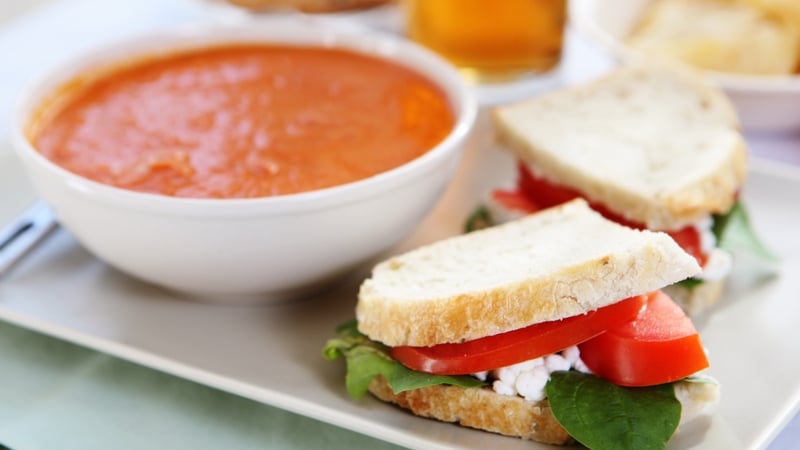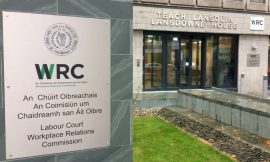We all love a little treat now and then – a coffee, a pastry, maybe a chicken sandwich on your lunch break.
But what happens when a sandwich and a cup of soup sets you back €17.50?
That’s exactly what happened when I was in Cork two weeks ago.
We were on holiday in the rebel county on a family day trip – two parents, two small children and two grandparents.
Inevitably we were delayed with the activities we were pursuing. The packed lunches were eaten, and everyone was hungry and cranky.
This led to a search for somewhere to get a small lunch. We planned to cook dinner at home later that evening.
After a while, we found a place in a local café. We secured a table for six and when the menu was delivered to the table I was shocked by the prices on the menu.
My dad ordered a sandwich. It was modest and comprised of organic chicken, onion, peppers, cheese, sourdough and, on the side, about two tablespoons of potato salad, some pickles and a cup of soup.
I was floored by the price.
It cost €17.50.
I only ordered a coffee. I felt I could not justify paying that much for lunch.
With this in mind, I brought a photo of the food out and about to get the reaction of punters in Dublin yesterday for Morning Ireland on RTÉ Radio 1.
Delivery man Graham Gallagher said he would not pay €17.50 for what he saw in the photo.
We need your consent to load this rte-player contentWe use rte-player to manage extra content that can set cookies on your device and collect data about your activity. Please review their details and accept them to load the content.Manage Preferences
“I certainly wouldn’t pay €17.50 for what you see on that plate there. I have a holiday home in Wexford. There is a place in Gorey – an absolutely beautiful little café – and for two to go in and eat it would still be less than what you’re showing me,” said Mr Gallagher.
“It is not looking too good in this country at the minute to be honest. Everything is gone up. People don’t have the money. It is definitely rip off Ireland – you can’t say it’s not,” added Mr Gallagher.
In line with what Graham Gallagher told me, there is value to be found all around Ireland when it comes to eating out.
Another woman told me she got two scones, a cup of tea and a can of coke for €10.95 in Dublin.
However, she also told me she was charged 3.50 for an extra tea bag in a pot of tea. On another occasion she was charged €3 for hot water.
The woman went for tea with her sister-in-law who asked for an extra tea bag in the pot of tea she was ordering.
“The tea was €3.50, and when she (her sister-in-law) looked (at the bill), it (the pot of tea) came to €7. He charged us €3.50 for the extra tea bag. They were just ordinary tea bags,” she said.
The man serving the women explained he had to charge for the extra tea bag. The women left the restaurant without consuming or paying for the food, leaving it at the till.
The same woman was at another restaurant with a group of friends and was charged €3 for boiling water.
“Another day my friend asked for extra hot water for her tea that she still had – €3. Now paying for hot water … three quid … and we had a big lunch,” added the woman.
Another woman in her 30s from Malahide told me she had paid between €12 and €13 for a cheese and ham toastie at a food market.
“It was only ham and cheese,” she said, describing the price as “robbery”.

Rising costs leading to change in consumer habits
But the price of putting food on a plate is not simple.
There are costs facing food producers – including staff costs, rates, energy costs and the costs of the food itself.
Michael Vaughan, owner of the Vaughan Lodge Hotel and Restaurant in Lahinch, Co Clare, told Morning Ireland the cost of producing the €17.50 sandwich and soup in Cork would be roughly €5.05.
But he stressed this is only about a third of what it takes to get a plate of food to the table.
If he was selling such a sandwich and soup, he would do so for about €16.
“I have looked at all the ingredients. It was chicken sandwich – the chicken was a premium chicken, it was organic. At cost you’d pay €2.10 for the chicken. 55 cent for the bread. Potato salad 50 cent. The soup €1.75. The garnish about 15 cent. So, it would cost about €5.05 – at cost,” said Mr Vaughan.
“But the thing is that the €5.05 – that only represents about 35% of the total cost. If I was building that cost to allow for other costs that I have I’d be looking to get between €16 and €17 for what you got,” he added.
The reason, he explained, was that staff labour cost represent another third of the final cost.
On top of this there are rates, electricity and overhead costs to take into account.
“When you add all of the costs up, when you do the maths on that, you are up as far as €16. But the owner is only getting about €1 of that as pure profit,” added Mr Vaughan.
The impact of rising costs means that people are ordering less when they go to restaurants, according to Vaughan.
“I see a huge change in the pattern of dining – evening in my own restaurant. We used to serve a set meal for €70 last year but I felt it was too much. This year we stripped it all back to individually priced items,” said Mr Vaughan.
“People are now cutting back completely on what they eat. They are not having a dessert, or they are not having a starter. They are having whatever they can afford,” Mr Vaughan added.
“Even people are just coming out to have a starter and a dessert on a night out,” said Mr Vaughan.
“The one thing we are not seeing any more is people drinking wine. Wine and spirit sales have plummeted by up to 15% to 20% from where they were. It’s the biggest change I have seen in my lifetime,” said Michael Vaughan who has been a hotelier for 41 years.

Call for restoration of 9% hospitality VAT rate
The Irish Tourism Industry Confederation says Ireland is still good value for money.
It’s CEO Eoghan O’Meara Walsh told Morning Ireland we are “certainly not the cheapest destination in Europe. We can’t compare to Mediterranean countries”.
“If you look at Eurostat figures that came out last month, which rated us as the second most expensive country in the EU … that feeds its way through to restaurant bills, to pub prices, to hotel prices. What is critical for the Irish tourism industry is that we maintain value for money,” said Mr O’Meara Walsh.
“I would argue that Irish Tourism is value for money. Fáilte Ireland do surveys amongst tourists to ascertain whether they found the Irish tourism experience value for money and thankfully out ratings still remain high. We are not the cheapest destination … but we do continue to offer value for money and it is vital that we retain that,” said Mr O’Meara Walsh.
Last week, the Irish Tourism Industry Confederation (ITIC) called for the lifting of the Dublin Airport passenger cap, increased Government spending, as well as the restoration of the 9% hospitality VAT rate in order to boost tourism in the country, which it said is at a “tipping point”.
In its Budget submission, the ITIC warned of “double-digit” decline in tourists coming to Ireland and that the country is overdependent on US visitors.
Restaurants Association of Ireland CEO Adrian Cummins said the hospitality VAT rate cut from 13.5% to 9% needs to happen to offer hospitality businesses a lifeline.
“The cost of business has increased substantially for our sector over the last number of years,” he said.
Referring to the €17.50 sandwich and soup he said: “I am sure that this business is trying to make a margin. At the end of the day, they have to make a profit. If their customers are paying €17.50 that is the price that they feel as a business that will attract customers in their door.
“Each business will set their own price – it is not for me to determine, we are prohibited from doing that – but I have to reiterate the cost of business has increased substantially over the last two-and-a-half years.
“VAT should be reduced because what we are trying to do here is make our industry sustainable. The reason why so many businesses are going out of business is the cost increase over the last number of years.
“The 9% will give a lifeline to our industry because every two months businesses have to pay their VAT. It will mean the VAT bill will come down by 50%. It means a better cash flow for them over the twelve months.
“It relieves pressure on those businesses that are paying their VAT for this year but also maybe paying warehouse tax accumulated during the pandemic.
“There are 20,000 food service businesses in the country between coffee shops, restaurants, food-to-go operations … the vast majority of the hospitality sector want that 9% VAT rate introduced as soon as possible.
“It is in the Programme for Government and they want the Government to deliver on it.”




